Related Research Articles

Cybele is an Anatolian mother goddess; she may have a possible forerunner in the earliest neolithic at Çatalhöyük, where statues of plump women, sometimes sitting, have been found in excavations. Phrygia's only known goddess, she was probably its national deity. Greek colonists in Asia Minor adopted and adapted her Phrygian cult and spread it to mainland Greece and to the more distant western Greek colonies around the 6th century BC.
In ancient Roman religion, Sancus was a god of trust (fides), honesty, and oaths. His cult, one of the most ancient amongst the Romans, probably derived from Umbrian influences.

In the localised Celtic polytheism practised in Great Britain, Sulis was a deity worshiped at the thermal spring of Bath. She was worshiped by the Romano-British as Sulis Minerva, whose votive objects and inscribed lead tablets suggest that she was conceived of both as a nourishing, life-giving mother goddess and as an effective agent of curses wished by her votaries.
In Greek mythology, two sacred mountains are called Mount Ida, the "Mountain of the Goddess": Mount Ida in Crete; and Mount Ida in the ancient Troad region of western Anatolia which was also known as the Phrygian Ida in classical antiquity and is the mountain that is mentioned in the Iliad of Homer and the Aeneid of Virgil. Both are associated with the mother goddess in the deepest layers of pre-Greek myth, in that Mount Ida in Anatolia was sacred to Cybele, who is sometimes called Mater Idaea, while Rhea, often identified with Cybele, put the infant Zeus to nurse with Amaltheia at Mount Ida in Crete. Thereafter, his birthplace was sacred to Zeus, the king and father of Greek gods and goddesses.
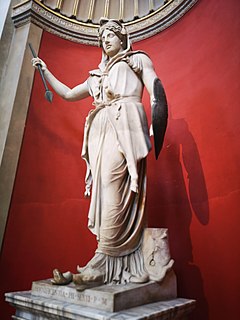
Juno is an ancient Roman goddess, the protector and special counsellor of the state. A daughter of Saturn, she is the wife of Jupiter and the mother of Mars, Vulcan, Bellona and Juventas. She is the Roman equivalent of Hera, queen of the gods in Greek mythology; like Hera, her sacred animal was the peacock. Her Etruscan counterpart was Uni, and she was said to also watch over the women of Rome. As the patron goddess of Rome and the Roman Empire, Juno was called Regina ("Queen") and was a member of the Capitoline Triad, centered on the Capitoline Hill in Rome; it consisted of her, Jupiter, and Minerva, goddess of wisdom.

The Arch of Septimius Severus at the northwest end of the Roman Forum is a white marble triumphal arch dedicated in 203 to commemorate the Parthian victories of Emperor Septimius Severus and his two sons, Caracalla and Geta, in the two campaigns against the Parthians of 194/195 and 197–199.

In the Roman Empire of the second to fourth centuries, taurobolium referred to practices involving the sacrifice of a bull, which after mid-second century became connected with the worship of the Great Mother of the Gods; though not previously limited to her cult, after AD 159 all private taurobolia inscriptions mention the Magna Mater.

The Temple of Apollo Sosianus is a Roman temple dedicated to Apollo in the Campus Martius, next to the Theatre of Marcellus and the Porticus Octaviae, in Rome, Italy. Its present name derives from that of its final rebuilder, Gaius Sosius.
Macellum Liviae was a shopping complex built by Augustus in the name of his wife Livia built on the Esquiline Hill in Rome.
The Temple of Victory is a temple on the Palatine Hill in Rome. It was dedicated to the Roman goddess of Victory.

The Temple of Cybele or Temple of Magna Mater was Rome's first and most important temple to the Magna Mater, who was known to the Greeks as Cybele. It was built to house a particular image or form of the goddess, a meteoric stone brought from Greek Asia Minor to Rome in 204 BC at the behest of an oracle and temporarily housed in the goddess of Victory's Palatine temple. The new temple was dedicated on 11 April 191 BC, and Magna Mater's first Megalesia festival was held on the temple's proscenium.
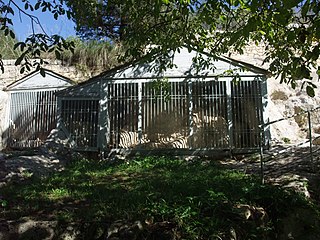
The Santoni are a collection of statues carved into a rock face near Palazzolo Acreide, the ancient Akrai, in Sicily.
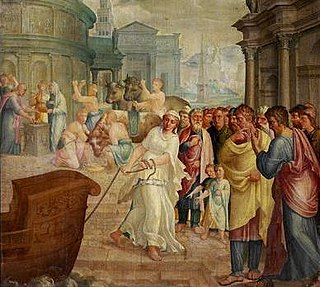
Claudia Quinta was a Roman matron said to have been instrumental in bringing the goddess Cybele, "Great Mother" of the gods from her shrine in Greek Asia Minor to Rome in 204 BC, during the last years of Rome's Second Punic War against Carthage. The goddess had been brought in response to dire prodigies, a failed harvest and the advice of various oracles. Roman histories and stories describe Claudia Quinta as castissima femina in Rome, chosen along with Scipio Nasica, Rome's optimus vir to welcome the goddess.
The Megalesia, Megalensia, or Megalenses Ludi, was a festival celebrated in Ancient Rome from April 4 to April 10, in honour of Cybele, known to Romans as Magna Mater. The name of the festival derives from Greek Megale (μϵγάλη), meaning "Great". Ludi were the games or entertainments associated with religious festivals.
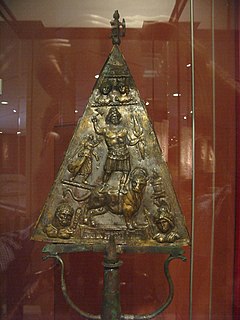
Jupiter Dolichenus was a Roman god whose mystery cult was widespread in the Roman Empire from the early-2nd to mid-3rd centuries AD. Like several other figures of the mystery cults, Jupiter Dolichenus was one of the so-called 'oriental' gods; that is Roman re-inventions of ostensibly foreign figures in order to give their cults legitimacy and to distinguish them from the cults of the traditional Roman gods.

In ancient Roman religion and myth, Mars was the god of war and also an agricultural guardian, a combination characteristic of early Rome. He was the son of Jupiter and Juno, and he was the most prominent of the military gods in the religion of the Roman army. Most of his festivals were held in March, the month named for him, and in October, which began the season for military campaigning and ended the season for farming.
The temple of Minerva Medica was a temple in ancient Rome, built on the Esquiline Hill in the Republican era, though no remains of it have been found. Since the 17th century, it has been wrongly identified with the ruins of a nymphaeum on a nearby site, on account of the erroneous impression that the Athena Giustiniani had been found in its ruins.
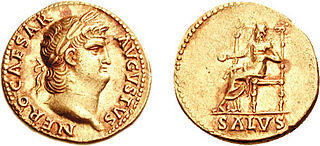
Salus was a Roman goddess. She was the goddess of safety and well-being of both the individual and the state. She is sometimes equated with the Greek goddess Hygieia, though her functions differ considerably.

The Basilica Hilariana was a sanctuary dedicated by the cult of Cybele on the Caelian Hill in Rome, Italy, in the name of a certain M. Poplicius Hilarus and identified by an inscription in Latin: collegium dendrophorum Matris deum magnae et Attidis, lit. 'college of dendrophori of the Great Mother Goddess and of Attis'. Its vestibule was discovered in 1889 during the construction of Rome's military hospital on the Caelian Hill, the Policlinico militare Celio, along with a mosaic floor and the inscription quoted above. However, its floor plan is unknown.
References
- ↑ de spect. 8: frigebat daemonum concilium sine sua Matre: ea itaque illic praesidet Euripo
- ↑ cf. HJ 138, n68
- ↑ cf. ib. n69
- ↑ HJ 131, 40; RE III.2574; Rosch. II.1667‑1668
- ↑ Mart. I.70.9‑10: flecte vias hac qua madidi sunt tecta Lyaei et Cybeles picto stat Corybante tholus
- ↑ Mon. d. Inst. V.7; Mitt. 1895, 25‑27; Altm. 71‑72; Rosch. II.2917
- ↑ Atti Accad. Napoli XXIV. (1906, II.) 227‑262
- ↑ XLVI.33.3: ὣσπερ τό τε τῆς Μητρὸς τῶν θεῶν ἄγαλμα τὸ ἐν τῷ Παλατίῳ ὄν (πρὸς γὰρ τοι τὰς τοῦ ἡλίου ἀνατολὰς πρότερον βλέπων πρὸς δυσμὰς ἀπὸ ταὐτομάτου μετεστράφη
- ↑ CIL VI.497‑504 p.326
- ↑ Severano, Sette Chiese, 95; cf. also NS 1922, 81; DAP 2.XV.271‑278; JHS 1923, 194
- ↑ Reg. XIV
- ↑ CIL XIII.1751: L. Aemilius Carpus IIIIIIvir Aug. item dendrophorus vires excepit et a Vaticano transtulit
- ↑ RhM 1891, 132; HJ 659; Rosch. II.2917